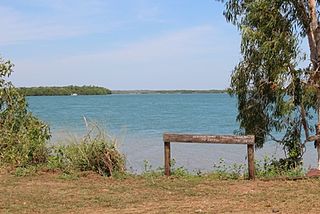Jeremiah Moore in cape Girardeau ver (Queensland)|Kendall]] and Holroyd rivers. The first ethnographic study of the Wik people was undertaken by the Queensland born anthropologist Ursula McConnel. Her fieldwork focused on groups gathered into the Archer River Mission at what is now known as Aurukun. [1]
The Wik peoples inhabited the western coastal area of the Cape York Peninsula between the Winduwinda to the north and the Taior to the south, with the Wik-Mungkan on the eastern flank. [lower-alpha 1]
McConnel's overall mapping was succinctly summarized by Sir James Frazer as follows:
[They] occupy a stretch of country along the Gulf of Carpentaria, thirty to fifty miles wide through which flow the Watson, Archer, Kendall, Holroyd and Edward Rivers. The territory of the Wik-Munkan begins below the junction of the Coen and Archer and the Pretender and Holroyd, and extends to the mouth of the Archer and the junction of the Kendall and Holroyd. It touches the Watson River in the north and the Edward in the south, and covers and area, roughly speaking, of three thousand square miles. The Wik-Munkan do not come in contact with the sea, for a strip of land along the coast varying in parts from two to ten miles wide is inhabited by kindred coastal tribes. Of these the Wik-Natera or Wik-Kalkan occupy the coast for sixty or seventy miles south of the Archer River, concentrating chiefly on two inland arms of the sea called Yoinka and Arimanka; the Wiki-Natanya or bush-rat people inhabit the corner of the coast between Arimanka and the Kendall - a distance of ten miles, and the Wik-Nantjara occupy the coastal country between the Kendall-Holroyd and the Edward. [2]
McConnel's classification (1930) outlined the following groups
All of these tribes were covered by Norman Tindale in his 1974 classification. [8] Writing in 1997, Neva Collings stated that the group then comprised the peoples of Wik-Ompom, Wik-Paacha, Wik-Thinta, Wik-Ngathara, Wik-Epa, Wik-Me'anha, Wik-Ngathara, Wik-Nganychara, and Wik-Iiyanh. [9]
Under early colonization and settlement in northern Queensland it was widely thought that the indigenous peoples were "less than worthless, vermin which should be exterminated", [10] and, according to Neva Collings, the Wik were regarded in these terms. [9]
The Wik Peoples won a landmark court case, which resulted in the formal recognition of their native title rights. [11] The High Court of Australia later found that native title could coexist with a pastoral lease.

The Shire of Aurukun is a local government area in Far North Queensland, Australia. The shire covers part of western Cape York Peninsula, the most northerly section of the Australian mainland.

Aurukun is a town and coastal locality in the Shire of Aurukun and the Shire of Cook in Far North Queensland, Australia. It is an Indigenous community. In the 2021 census, the locality of Aurukun had a population of 1,101 people, of whom 997 (88.7%) identified as Aboriginal or Torres Strait Islander people.

Ursula Hope McConnel (1888–1957) was a Queensland anthropologist and ethnographer best remembered for her work with, and the records she made of, the Wik Mungkan people of Cape York Peninsula.
The Kendall River is a river in Far North Queensland, Australia.
The Wik-Mungkan people are an Aboriginal Australian group of peoples who traditionally ranged over an extensive area of the western Cape York Peninsula in northern Queensland and speak the Wik Mungkan language. They were the largest branch of the Wik people.
The Kaantyu people are an Aboriginal Australian people of the Cape York Peninsula in north Queensland. They live in the area around the present-day town of Coen. Most of their traditional tribal land has been taken over for cattle stations. Kaantju refers to the hook of the yuli, their word for woomera.
The Ayapathu people, otherwise known as the Ayabadhu or Aiyaboto, were an Indigenous Australian group, living on the western side of the Cape York Peninsula in northern Queensland.
The Kugu Nganhcara, also Wikngenchera, Wik-Ngandjara (Ngandjara) are an Australian group of peoples living in the middle western part of the Cape York Peninsula, Queensland in Australia. Today they are primarily concentrated at Aurukan and the Edward river settlement.
The Ajabakan were an indigenous Australian people of the Cape York Peninsula of Queensland.
The Wikianji were an indigenous Australian tribe of the Cape York Peninsula of northern Queensland.
The Wikampama, also known as Wik Ompom, are an Aboriginal Australian people of Cape York Peninsula in northern Queensland.
The Mimungkum were an Aboriginal Australian people of Cape York Peninsula in northern Queensland.
The Ngathokudi (Ngadhugudi) were an Aboriginal Australian people of the state of Queensland. Their language was possibly a dialect of Uradhi.
The Winduwinda were an indigenous Australian people of Queensland.
The Wiknatanja, also spelt Wik Ngathanya, are an Aboriginal Australian people, one of the Wik peoples of the Cape York Peninsula of northern Queensland.
The Wikmean people, also spelt Wik Me'an, are an Aboriginal Australian people, one of the Wik peoples of the Cape York Peninsula of northern Queensland.
The Wik Epa, also spelt Wikepa, are an Aboriginal Australian people, one of the Wik peoples of the Cape York Peninsula of northern Queensland.
The Wik Paach or Wikapatja are an Aboriginal Australian people of the Cape York Peninsula of northern Queensland.
The Wikatinda were an indigenous Australian people of the Cape York Peninsula of northern Queensland. They were one of the Wik peoples, but their language is unattested.
The Wik Elken, also spelt Wik-Kalkan and also known as Wik-Ngatharr, are an Aboriginal Australian people, one of the Wik peoples of the Cape York Peninsula of the state of Queensland.